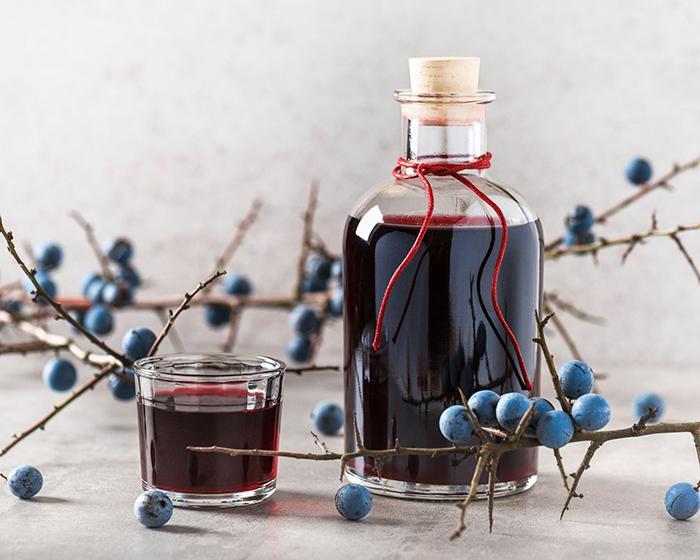Ever been curious about what exactly sloe gin is?
This unique British liqueur, infused with the tart flavors of slow berries soaked in gin, is an intriguing concoction.
You Are Watching: What Is Sloe Gin Updated 07/2025
Our comprehensive guide will demystify this intricate beverage, providing you everything from its origins and ingredients to how it compares to traditional gin.
Let’s dive into the world of sloe gin – a world that’s full of flavor and intrigue!
What is Sloe Gin?

Sloe gin is a British liqueur made by soaking sloe berries in gin, resulting in a tart and almond-flavored drink.
Sloe gin vs traditional gin
Though both sloe gin and traditional gin share a similar base ingredient, they differ significantly in flavor, ingredients, and alcohol content.
| Sloe Gin | Traditional Gin | |
|---|---|---|
| Primary Ingredients | Sloe gin’s primary ingredient is the sloe berries from the Prunus spinosa plant, which are infused into gin. | Traditional gin’s primary ingredient is juniper berries which give it a distinctive pine flavor. |
| Flavor Profile | Sloe gin is often described as sweet and fruity, with a berry-like flavor and a tart undertone from the sloe berries. | Traditional gin has a sharper, more botanical flavor due to the juniper berries and other botanicals used in its production. |
| Alcohol Content | Sloe gin typically has an alcohol content between 15 and 30 percent, which is lower than most spirits. | Traditional gin, on the other hand, usually has a higher alcohol content, typically around 40 percent. |
| Usage | Sloe gin is often enjoyed on its own as a warming drink during winter, or mixed into cocktails for a summer refreshment. | Traditional gin is versatile, commonly enjoyed neat, on the rocks, or as the base in cocktails like a martini or gin and tonic. |
Ingredients and process
Sloe gin is made by infusing sloe berries in gin, resulting in a unique and flavorful liqueur. Here’s how it’s done:
- Sloe berries: The main ingredient of sloe gin is sloe berries, which are small, dark-colored fruits from the blackthorn plant, also known as Prunus spinosa.
- Gin: High-quality gin serves as the base for sloe gin. Juniper berries, along with other botanicals such as coriander and citrus peel, give gin its distinct flavor.
- Mashing the berries: Once harvested, the sloe berries are traditionally pricked with a thorny branch or fork to release their juices and flavors.
- Soaking in gin: The pricked sloe berries are then added to a container or jar filled with gin. The ratio of berries to gin can vary depending on personal preference, but a common guideline is around 1 pound of berries per liter of gin.
- Sugar addition: To balance out the tartness of the sloe berries, sugar is often added during the infusion process. This step brings out the natural sweetness of the fruit and creates a harmonious flavor profile.
- Aging period: Unlike traditional gin, which can be enjoyed immediately after distillation, sloe gin requires a period of aging to allow the flavors to meld together and develop complexity. It is common to let the mixture steep for several months or even up to a year.
- Straining and bottling: After the desired aging period has passed, the mixture is strained through cheesecloth or a fine mesh sieve to remove any solids or impurities. The resulting liquid is then bottled and ready for consumption.
Alcohol content
Sloe gin has a lower alcoholic content compared to regular gin, typically ranging from 15 to 30 percent by volume.
This makes it milder and easier to drink for those who prefer a less strong spirit.
The lower alcohol content also allows the flavors of the sloe berries to shine through, creating a fruity and enjoyable liqueur.
So if you’re looking for a deliciously smooth and slightly less potent option, sloe gin is definitely worth giving a try.
How Does Sloe Gin Differ from Other Types of Gin?

Flavor profile
Sloe gin is known for its unique and delightful flavor profile. This fruit-infused liqueur offers a balance of sweetness and acidity that is truly satisfying to the palate.
With its prominent berry flavors and herbal undertones, sloe gin adds a delicious twist to classic cocktails.
Read More : Popular Korean Liquor Updated 07/2025
Unlike traditional gin, which has juniper as its primary flavor, sloe gin showcases the rich taste of sloe berries.
These small dark fruits impart a luscious sweetness to the spirit while maintaining its distinctively botanical character.
Whether sipped on its own or mixed into creative concoctions, sloe gin brings a burst of fruity goodness to any drink experience.
So go ahead and indulge in this plum-based spirit – you won’t be disappointed!
Sweetness
Sloe gin is known for its delightful sweetness, which sets it apart from traditional gin.
The infusion of sloe berries in the gin base adds a natural fruity and slightly sweet flavor to the liqueur.
This sweetness balances out the tartness of the berries, creating a harmonious and enjoyable taste.
When you sip on sloe gin, you’ll experience notes of plum and berry flavors with subtle herbal undertones from the juniper in the gin.
It’s this combination that makes sloe gin a versatile spirit that can be enjoyed neat or used as an ingredient in various cocktails.
So if you have a sweet tooth or simply enjoy fruit-infused spirits, sloe gin might just become your new favorite drink!
Uses and cocktails
Sloe gin is a versatile liqueur that can be enjoyed in a variety of ways. Here are some uses and cocktail ideas for sloe gin:
- Sloe Gin Fizz: Mix sloe gin with lemon juice, simple syrup, and club soda for a refreshing and bubbly cocktail.
- Sloe Gin Negroni: Replace Campari with sloe gin in the classic Negroni recipe for a fruity twist on this popular cocktail.
- Sloe Gin Sour: Combine sloe gin with fresh lemon juice and simple syrup for a tangy and sweet sour cocktail.
- Sloe Gin Martini: Swap out regular gin with sloe gin in your favorite martini recipe to add a hint of fruitiness to your drink.
- Sloesecco: Mix sloe gin with sparkling wine or champagne for a fruity and celebratory drink.
- Sloesecco Royale: Add a splash of sloe gin to your glass of sparkling wine or champagne, along with some fresh berries, for an elegant and fruity twist.
- Sloe Gin Collins: Similar to the classic Tom Collins, mix sloe gin with lemon juice, simple syrup, and club soda for a tall and refreshing cocktail.
What Does Sloe Gin Taste Like?

Berry flavors
Sloe gin is renowned for its luscious berry flavors that add a delightful twist to the traditional gin.
Infused with sloe berries, this fruity liqueur offers a burst of sweet and tangy notes that make it a perfect choice for those craving something different from regular gin.
The dark-colored sloe berries lend their unique essence, resulting in a rich and vibrant taste profile that balances sweetness with hints of tartness.
These natural flavors create a harmonious blend when combined with the herbal undertones and juniper base of the gin.
Read More : Svedka Vodka Review Updated 07/2025
Whether sipped neat or used as an ingredient in cocktails, sloe gin’s distinct berry infusion adds a refreshing dimension to any drinking experience.
Herbal undertones
Sloe gin is known for its unique herbal undertones, which add depth and complexity to its flavor profile.
While traditional gin gets most of its flavor from juniper berries, sloe gin incorporates the earthy and herbal notes of purple sloe berries.
These berries, also known as blackthorn or sloes, have a distinct taste that infuses the gin with a subtle bitterness and a touch of almond-like flavor.
The combination of these herbal undertones with the sweetness of the fruit creates a well-balanced liqueur that is both refreshing and comforting.
Whether enjoyed neat or mixed in cocktails, sloe gin’s herbal character adds an extra layer of sophistication to any drink.
So if you’re looking for something different from your regular gin experience, give sloe gin a try and savor those delightful herbal undertones.
Balance of sweetness and acidity
Sloe gin offers a delightful balance of sweetness and acidity that sets it apart from other types of gin.
The infusion of sloe berries in the gin base adds a natural sweetness to the spirit, while still allowing the tartness of the berries to shine through.
This combination creates a unique flavor profile that is both fruity and refreshing.
Unlike traditional gins which tend to lean towards more herbal and juniper-forward tastes, sloe gin provides a sweeter alternative with subtle undertones of herbs and spices.
It’s no wonder why this fruit-infused liqueur has become such a popular choice for cocktails and gatherings.
So if you’re looking for something different to sip on, give sloe gin a try – its perfect balance might just surprise your taste buds!
Conclusion
In conclusion, sloe gin is a delightful British liqueur made by infusing sloe berries in gin. The result is a sweet and fruity spirit with hints of berry flavors and herbal undertones.
With its lower alcohol content and unique flavor profile, sloe gin offers a delicious twist on traditional gin that can be enjoyed on its own or mixed into creative cocktails.
Cheers to discovering the wonderful world of sloe gin!
Sources: https://chesbrewco.com
Category: Wine










